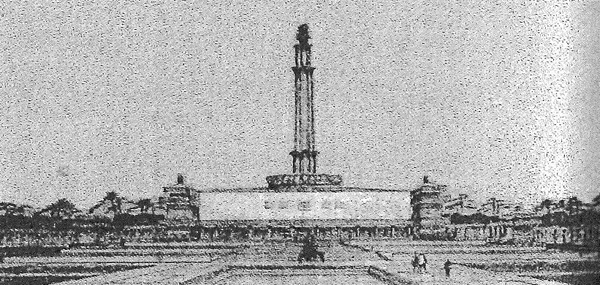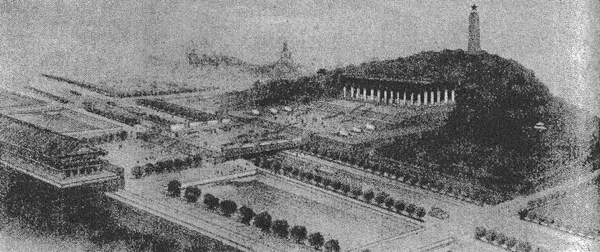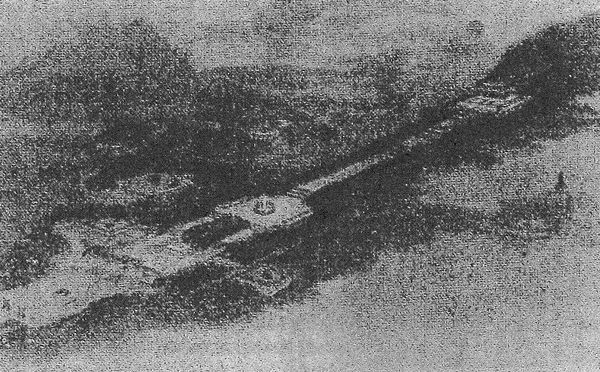|
|||||||||
|
FEATURESA Beijing That Isn't (Part I)Sang Ye and Geremie R. BarméThere have been numerous plans for the reconstruction of Beijing, or the redesign of areas of the city as it has expanded over the years. Some of the most dramatic plans centred along the axial road that itself first came into being in the early days of the Republic of China. What is now Chang'an Boulevard (Chang'an Dajie) was a short thoroughfare punctuated by gates and memorial arches until its extension and the expansion of Tiananmen Square in the 1950s. The history of the square and the boulevard are much discussed elsewhere, as are the various monumental buildings both of the socialist and the hypersocialist eras. But what of the other plans for the city, and the buildings, aspirational and otherwise, that were never realised? The following account discusses some of the plans for the city's political, social and cultural life that were mooted, some even partially realised, but then abandoned. It is an account of a Beijing that did not come into being, of a Beijing that isn't. Along with Beijing Underground, another essay in the Features section of this issue, we reflect on the unrealised heritage of the city, the unbuilt Beijing. An Imperial ParliamentDiscussions of political reform in China often hark back to a dim tradition of change within autocracy. In particular, the period of the Tongzhi Restoration (Tongzhi zhongxing) following the Xinyou Coup of 1860, which brought Prince Gong (Yixin), and the woman who would be known to history as the Empress Dowager Cixi, to power, as well as the 'New Policies' (Xinzheng) from early 1901 onwards. In July 1905, the Empress Dowager Cixi directed five imperial officials to undertake a 'constitutional mission', a survey of the major political systems of the world powers with the aim of creating a more modern, and internationally acceptable, polity for China. Following the return of the imperial delegation in August 1906, it was recommended to the throne that a form of constitutional government be adopted. The next month Cixi issue an edict in which it was declared that while power would remain with the court, a form of popular participation in political deliberations would now be allowed. News reports in early October claimed that there widespread celebrations of this sage decision and, in February 1907, the empress ordered the creation of a Consultative Assembly (Zizheng Yuan). Later that year, she declared it her aim to establish a 'bicameral deliberative body', as well as an independent judiciary. In his 1908 deathbed edict, the Guangxu Emperor enjoined his subjects to pursue these political reforms and proceed with efforts to create the promised Consultative Assembly. In September 1910, the assembly was formally inaugurated and its first session was held the following month at a temporary site in the Capital Institute of Law (or Beijing Law School, Jingshi Falü Xuetang) which had been established in 1906 under the aegis of the New Policies. It consisted of 98 delegates chosen by the court and another 98 representing the regional interests.  Fig. 1 The architect's vision for the Imperial Consultative Assembly building. A site for a permanent home for the new Imperial Consultative Assembly was selected in July 1907. It was the former location of the Imperial Examination Halls, or Gong Yuan, on the north side of what is now Jianguo Mennei Boulevard. The German architectural firm of Curt Rothkegel (1876-1946) was commissioned to draw up plans for the new building and these were submitted to the throne in July 1910. In December that year a budget was finalised and construction began. The Consultative Assembly building was designed in the style of a German Renaissance structure, sharing some similarities to the Bundestag in Berlin. It too had three cupolas, but was four storeys high. The structure had a central octagonal hall with the senate (Canyi Yuan), or upper house on the right-hand side of the main entrance and a congress (Zhongyi Yuan), or lower house, on the left. Both houses would be able to seat 1200 delegates (yiyuan) and 350 auditors. The second floor was reserved for the public and journalists, and was installed with various kinds of modern communications equipment. The third floor provided office space for delegates, while a library was situated on the fourth floor. Modern appointments such as an elevator, an up-to-date dining hall and lavatory facilities were also featured Rothkegel's design. A 'democracy plaza' (minyi guangchang) for popular gatherings and discussions was laid out on the south side of the building.  Fig. 2 The foundations laid for the never-to-be-built Consultative Assembly on the site of the Imperial Examination Halls. At the time of the October 1911 Xinhai Revolution, the foundations for the assembly building had already been laid, and work had begun on the walls. These were demolished in the early years of the new Republic of China and plans were mooted for it to be replaced by a sports field. Even this failed to eventuate. The land was auctioned off and the proceeds were used to cover the unpaid salaries of employees of the National Assembly and the Ministry of Internal Affairs.  Fig. 3 The Temporary National Assembly Building of the Republic of China and Offices, now part of the Xinhua News Agency compound. While his plans for the Consultative Assembly were not realised, Rothkegel had an impact on Beijing in a number of ways (see 'Zhu Qiqian's Silver Shovel' in Features in this issue). He also designed a temporary site for the Republican National Assembly in 1913, while his 1911 design for the Peking Club was soon realised. Rothkegel's Peking Club was known during the early Republic as the 'Western Gentleman's Club' (Xishen Zonghui). It was later called the International Club (Wanguo Julebu). Under the People's Republic this became Guoji Julebu. Originally located on Dongxiao Minxiang Alley in the old embassy quarter, the club was removed to its present site at Jianguo Menwai during the late years of the Cultural Revolution. Today, Rothkegel's building is the Activities Centre for the Retired Cadres of the United Front Department of the Beijing Municipal Party Committee. The Temporary National Assembly Building of the Republic of China and Offices, located on the western side of Xuanwu Men (62 Tonglin Ge Lu), took its basic floor plan from the defunct imperial Consultative Assembly. It is now the location of the Reference News (Neican) Office and Printing Factory of Xinhua News Agency. Sources:Qing Shilu. Guangxu chao Donghua lu. Far Eastern Review, September 1913. Shen bao, 6 October 1906. Torsten Warner, German Architecture in China: Architectural Transfer/ Deutsche Architektur in China : Architekturtransfer, Ernst and Sohn, 1994. Redesigning the Hall of Supreme HarmonyIn April 1913, the new bicameral National Assembly of the Republic of China held its first sitting in Beijing. The Senate established itself in the old Political Advisory Council of the Qing dynasty at the Capital Institute of Law (Jingshi Falü Xuetang), while the Congress was housed in the Capital Finance Institute (Jingshi Caizheng Xuetang). The new buildings were designed by the Qingdao-based German architect Curt Rothkegel and were in use from 1913. Rothkegel is known for work on the redesigned Qian Men and Zhengyang Men Gates (see 'Zhu Qiqian's Silver Shovel' in Features), as well as for the Gallery of Antiquities in the Forbidden City.[1]  Fig. 4 The Hall of Supreme Harmony. The National Assembly experience a tumultuous first decade. Voted in for a three year term by a small electorate, its sporadic tenure spread out over eleven years. It was a period of tireless strife, scandal, disruption and corruption. Ten years after the Assembly was first convened plans were proposed by the head of the Senate Wang Jiaxiang and his equivalent in the Congress, Wu Jinglian, for the Chinese parliament to move into the Three Halls, the main audience chambers of the former imperial palace. Ever since the halls had been vacated by the remnant imperial court following the abdication of the Xuantong Emperor (Puyi) in 1912, there had been concerns that royalists would attempt a restoration of the monarchy. Indeed there had been two abortive restorations, one by the President of the Republic of China himself, Yuan Shikai, who styled himself as a new emperor in 1915, and another two years later by Puyi's own court.[2] The Swedish architect Albin Stark (1885-1960), who had only just registered his company in Shanghai, was commissioned in February 1923 to take measurements of the Hall of Supreme Harmony and surrounds to prepare a brief for the new buildings. According to the hopes of the National Assembly leaders, the plan would require that the Hall of Supreme Harmony (Taihe Dian), seen by many as the symbolic centre of defunct imperial power, be replaced by a centre of Republican parliamentary power. Meanwhile, the two other halls of the Outer Court (Wai Chao) which are situated on the central axis of the Forbidden City, the Hall of Central Harmony (Zhonghe Dian) and the Hall of Preserving Harmony (Baohe Dian), would be refitted and replaced by offices serving the new parliament. Stark's plan, presented in April 1923, proposed a new parliament to be constructed within the existing Hall of Supreme Harmony with Western-style parliamentary office buildings built on either flank of the building. The refitting consisted of building suitable seating for some 1200 delegates, dignitaries and functionaries. The new structures which would be built following the demolition of the walls on either side of the old throne room and would contain reception halls for visiting dignitaries, a banquet hall, as well as rest areas for the head of the Assembly and the President. The plan to locate the Republican National Assembly in the centre of the old palace outraged the powerful northern warlord Wu Peifu, whose powerbase was in Beijing. In a telegram sent to Li Yuanhong, then President of the Republic, on 20 May 1923, Wu argued that if the central halls of the imperial palace were redesigned or, worse, demolished, "China will not only lose forever an ancient monument of great ingenuity, but it will also serve itself up to derision by all nations of the world."[3] 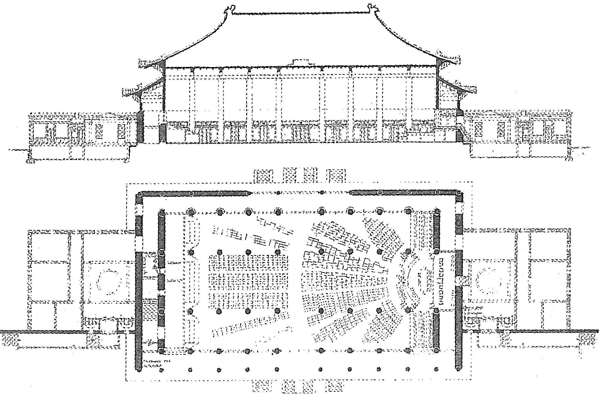 Fig. 5 Plan for the reconfiguration of the Hall of Supreme Harmony for the National Assembly of the Republic of China. In a gesture aimed at making public his objections, Wu Peifu released the text of his telegram to the Beijing newspaper, Shuntian shibao, in whose pages it was published on 22 May. This led to a speedy response from the two Assembly leaders, Wu Jiaxiang and Wu Jinglian, who sent a telegram to Wu on 26 May in which they reminded the warlord that the President of the Republic of China, Yuan Shikai, had been inaugurated in the Hall of Supreme Harmony just over a decade earlier, and that the defunct Qing court was still interested in using the ceremonial halls, and the dragon thrones, to return to power. They also said that if the halls remained abandoned they would soon fall into decay. After all, they asked, did not the Temple of Bountiful Harvest (Qinian Dian) at the Temple of Heaven (Tian Tan) find a new use as the place where the constitution of the Republic was drawn up, its side halls providing crucial office space for the officials involved in that process?[4]  Fig. 6 Alternate plan for the reconfiguration of the Hall of Supreme Harmony for the Republican parliament. As the supreme military leader in North China, with numerous provinces under his control, Wu Peifu was in an unassailable position, and he chose to ignore these impotent protests. In January 1924, Albin Stark quit China, his plans for the Hall of Supreme Harmony never having left the drawing board. He became active as a 'functionalist' architect and, among other things, designed The China Theatre in Stockholm. On 24 November 1924, the warlord Feng Yuxiang carried out a coup. He took control of the former imperial city, expelled the 'little court' of Puyi from the Forbidden City and dissolved the National Assembly. Notes:1. See Barmé, The Forbidden City, Cambridge, Ma.: Harvard University Press, 2008, pp.120-25. 2. For details of the struggle over the uses of the former imperial palace in the early years of the Republic, see Chapter 6, 'Within and Without the Palace', in Barmé, The Forbidden City, pp.114-29, and the online notes to this chapter at: http://www.chinaheritageproject.org/theforbiddencity/notes.php?chapter=chapter6 3. For Wu Peifu's telegram, see Shuntian shibao, 22 May 1923. 4. For the response to Wu Peifu, see Shuntian shibao, 27 May 1923. Sources:W. Perceval Yetts, 'Writings on Chinese Architecture', The Burlington Magazine for Connoisseurs, Vol. 50, No. 288 (March, 1927), pp.116-31. Zhongguo Shehuikexue Yuan Jindai Shi Yanjiu Suo, ed., Wusi aiguo yundong dang'an ziliao, Beijing: Zhongguo Shehuikexue Chubanshe, 1980, pp.351-55. Shuntian shibao, 22 May 1923 and 27 May 1923. Zhongguo jindai jianzhu chugao, Beijing: Zhongguo Jianzhu Kexue Yuan Dang'an, 1959 (unpublished). Zhang Fuhe, Beijing jindai jianzhu shi, Beijing: Qinghua Daxue Chubanshe, 2004, pp.187-190. The Chairman Mao Memorial HallAlthough Mao Zedong had declared himself in favour of cremation, within hours of his death on 9 September 1976 a struggle over the fate of his corpse led to a decision being made to preserve his body and place it on permanent public display. Eventually, a formal tomb, the Chairman Mao Memorial Hall, was constructed in the southern precinct of Tiananmen Square. 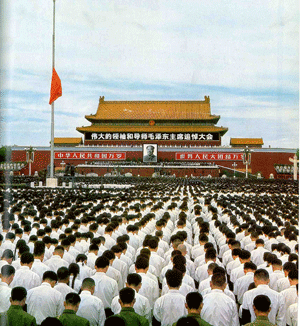 Fig. 7 Mao Zedong's funeral, Tiananmen Square. 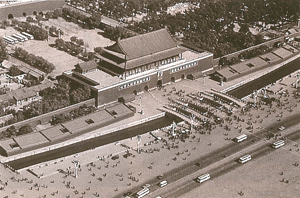 Fig. 8 Aerial view of Tiananmen Gate. A proposed Mao Memorial Hall would have been built between the marble bridges and the gate. Tiananmen was not the only choice for the construction of a Mao mausoleum. For a time a number of locations for a suitable structure to commemorate the life and achievements of the founder of the People's Republic of China were under discussion. These included: inside Tiananmen Gate, immediately outside it, on Prospect Hill and even in the Lake Palaces. Considerations to place the memorial in the Lake Palaces (Zhongnan Hai), Mao's official residence from the early days of the founding of the People's Republic, would have seen his corpse located in a dedicated hall built on the Ocean Terrace (Ying Tai), the island in the South Lake (Nan Hai), closest to the Chang'an Boulevard entrance to the party-state enclosure. Those in favour of this location also argued that it was the 'heart' of the People's Republic and that it would be easy to protect as the island was isolated and effectively cut off from land by a natural moat. The opposition pointed out that it would be far too close to the working centre of the nation's political and administrative life, not to mention the residences of key party leaders and their families. Moreover, the Ocean Terrace had been the main location of the Guangxu Emperor's 'house arrest' during the last decade of his life, following the abortive 100 Days Reforms of 1898 and the coup by military leaders who brought the Empress Dowager, Cixi, back into effective control of the empire. It was deemed highly inauspicious for this site to become the eternal resting place of China's beloved revolutionary leader and founder of the People's Republic. The proposal favouring the Lake Palaces was abandoned on 14 September, less than a week after Mao's demise. After surveys of various other sites by the Chairman Mao Memorial Hall Design Team, including Tiananmen, Duan Men, the Labouring People's Cultural Palace (Tai Miao), Prospect Hill (Jing Shan), Taoran Ting Park, the Fragrant Hills (Xiang Shan), etc, plans were considered for five potential locations. These were: 1. Tiananmen Gate. This proposal was developed in emulation of the Lenin (and for a time the Stalin) tomb in Moscow's Red Square. The plan would have seen a large building attached to the front of Tiananmen Gate in the location where an altar had been set up for Mao's funeral on 18 September 1976. The main argument against this proposal was that the area between the Golden Water River (Jinshui He) moat immediately in front of Tiananmen and the gate was relatively small, leaving little room for a structure of suitable magnificence and solemnity. Moreover, the gate itself, which was the ritual centre of state power, would have loomed over the tomb, thereby influencing the visual and symbolic impact of both the tomb and the gate. Lastly, it was noted that such a structure, and access to it, would have created serious transportation problems on Chang'an Boulevard. One of the key factors in deciding on the fifth location, south Tiananmen Square, and against the formal tomb in the Fragrant Hills was the opinion of the new Party Chairman, Hua Guofeng. Overriding the professional opinion of architects and advisers, Hua declared that, "Chairman Mao will live on in the hearts of the people. When they gather in mass meetings he will still be in their midst. We don't want a tomb up in the hills, or just a gravestone. Chairman Mao has to be in a building. He has to have a commemorative hall." This declaration put paid to the discussions leaving Tiananmen Square as the only viable option. 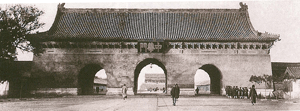 Fig. 12 China Gate (Zhonghua Men, formerly Da Ming Men and Da Qing Men), demolished in 1957 during the expansion of Tiananmen Square, now site of the Chairman Mao Memorial Hall. In the event, the Mao Memorial Hall was built on the north-south axis of Beijing between Zhengyang Gate and the Monument to the People's Heroes in the centre of Tiananmen Square. It is positioned on the former site of China Gate (Zhonghua Men), the Republican and early People's Republic name of what was originally the Great Ming Gate Da Ming Men latterly the Great Qing Gate Da Qing Men) which had been demolished during the late 1950s expansion of Tiananmen Square.[2] However, this decision created a new problem. During future mass meetings, demonstrations and parades, 'the people' would invariably stand facing Tiananmen Gate, with their backs to the dead chairman. Hua Guofeng now declared that such a sign of disrespect "would make me feel very uncomfortable". A member of the design team, Zhao Pengfei (the chief of the Beijing Construction Bureau at the time and a political appointee to the group) came up with a solution by suggesting that the gardens surrounding the commemorative hall should be reduced in size so that during mass rallies people would be able to gather all around the building, bringing to realisation Chairman Hua's hope that Mao would live forever among the masses. Once this problem had been solved there were intense discussions over designs for the final building. Architects from throughout the country were invited to make proposals and present them in Beijing. All together, 107 proposals were received. It was hoped that the final structure would outshine the tombs of other famous political leaders throughout the world, besting Lenin's Tomb, the Lincoln Memorial and the Thomas Jefferson Memorial, both in Washington, Georgi Dimitrov's Tomb in Bulgaria (torn down in 1999), as well as the Ho Chi Minh Mausoleum in Hanoi. The most outlandish of the many extraordinary designs was one that featured a 100-metre high red orb symbolising the sun rising in the east. The designed that was finally decided on, one for a relatively squat square building, was inspired by a proposal made by Yang Tingbao, the then deputy provincial governor of Jiangsu, a man who had trained as an architect at Pennsylvania University. 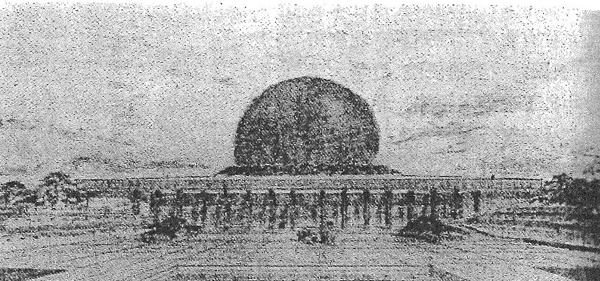 Fig. 13 A design for the Mao Memorial Hall in Tiananmen Square featuring a 'red sun'. A ceremony for the laying of the foundations for the Chairman Mao Commemorative Hall (Mao zhuxi Jinian Tang) was held in November 1976, some two months after Mao's demise. The building was completed in May of the following year and officially opened on the anniversary of the leader's death on 9 September 1977. The original sculptures at the gates outside the building were altered in 1980 to remove any reference to the Cultural Revolution. Although Mao's corpse remains in glorious isolation within the commemorative tomb, the dead chairman was subsequently joined by other Party leaders. From 1983, commemorative halls within the structure also celebrated the lives of Zhou Enlai, Liu Shaoqi and Zhu De. These were joined by displays for Deng Xiaoping and Chen Yun in 1999. Notes:1. For more on the funeral of Sun Yat-sen in Beijing in 1925 and his eventual entombment in the Purple Mountains outside Nanjing in 1929, both events which were echoed in the mourning for and burial of Mao, see Henrietta Harrison, The Making of the Republican Citizen, Political Ceremonies and Symbols in China, 1911-1929, Oxford: Oxford University Press, 2000, pp.133-44 and pp.207-35. 2. For more on the Mao Memorial Hall, see Rudolf G. Wagner, 'Reading the Chairman Mao Memorial Hall in Peking: The Tribulations of the Implied Pilgrim', in Susan Naquin and Chun-fang Yü, eds, Pilgirms and Sacred Sites in China, Berkeley: University of California Press, 1992, pp.378-423; and, Frederic Wakeman, Jr., 'Mao's Remains', in James L. Watson and Evelyn S. Rawski, eds, Death Ritual in Late Imperial and Modern China, Berkeley: University of California Press, 1988, pp.254-88. 3. The members of the Commemorative Hall design team were Xu Yinpei, Yuan Jingshen, Shen Bo, Ma Guoxiang, Geng Changfu, Fang Boyi, Wu Guanzhang and Zhao Pengfei. The worked under the immediate direction of Gu Mu, the head of the CCP Central Committee Office of the Leadership Group in Charge of Preserving Chairman Mao's Body, although the actual work involved in building the Commemorative Hall has directed by Li Ruihuan. Sources:Mao zhuxi Jinian Tang, Beijing: Renmin Chubanshe, 1979. Mao zhuxi Jinian Tang jianzhu tuji, Beijing: Jianzhu Gongye Chubanshe, 1979. Zhu Wenyi, 'Tiananmen Guangchang duandai shi', Sanlian Shenghuo Zhoukan, 2006: 3. Liao Gaolong, Zhonghua Renmin Gongheguo biannian shi, Kaifeng: Henan Renmin Chubanshe, 2000. Oral history interviews with members of the original design team: Ma Guoxiang; Yuan Jingshen and Shen Bo. Illustrations from:Mao zhuxi Jinian Tang fang'an: caotu in the Archives of the Research Institute of Chinese Architecture (Zhongguo Jianzhu Kexue Yanjiu Yuan dang'an), 1977. |
